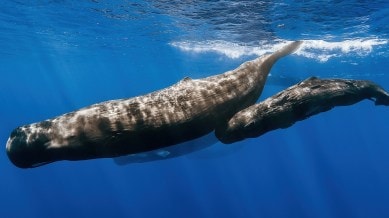📣 For more lifestyle news, click here to join our WhatsApp Channel and also follow us on Instagram
The loudest animal on Earth is much more louder than a jet engine at close range
Whether it’s a bird trying to impress a mate, a shrimp stunning its next meal, or a whale calling across the ocean, each creature uses sound in its own extraordinary way

When we think of loud animals, most imagine a lion’s roar or an elephant’s trumpet. But the actual noisiest creatures on the planet may surprise you. Some are deep-sea dwellers, others are tiny insects, and a few fly right above our heads.
Animals are loud for a few main reasons: to find a mate, defend their territory, communicate, or hunt. In water, sound travels faster and farther, so many marine animals use volume to their advantage. On land, loud calls can help animals be heard through dense forests or over long distances.
Let’s dive into the surprisingly noisy world of animals, where size doesn’t always match sound.
Sperm Whale
The crown for loudest animal goes to a creature of the deep: the sperm whale. These whales don’t just swim gracefully through the ocean; they click. Loudly. Their clicks can reach around 230 to 236 decibels (dB), far louder than a jet engine at close range.
These clicks are how sperm whales “see” underwater using echolocation and how they talk to one another. The sound is produced in a part of their head filled with oil called the spermaceti organ. It’s their version of sonar, and it’s incredibly powerful.
Pistol Shrimp
Another surprise contender is the tiny pistol shrimp, sometimes called the snapping shrimp. With a flick of its claw, it creates a bubble that bursts with a bang, reaching around 210 dB. That’s loud enough to stun or even kill small prey, and the sound happens so fast it creates heat and light for a split second.
It’s like an underwater gunshot, made with a single claw.
Blue whales and others
Whales, in general, are some of the loudest creatures on the planet. Blue whales, the largest animals on Earth, produce deep, low-frequency calls that can be as loud as 188 dB and travel hundreds of kilometres underwater.
Other whales, such as the bowhead and right whale, use their voices to communicate across long distances. Their haunting songs are beautiful and functional in the vast ocean.
Loudest land animals
Back on land, there are a few contenders too. The African elephant can trumpet at about 117 dB, and during mating season, northern elephant seals have been recorded at up to 131 dB.
The king of the jungle, the lion, lets out a roar that measures around 114 dB, loud enough to be heard up to 5 miles away. And then there’s the howler monkey, which might not seem intimidating, but their howls carry over large stretches of rainforest and can hit around 90 dB.
Birds aren’t far behind either
One of the loudest birds ever recorded is the white bellbird, which lives in the Amazon. Males use their deafening call—measured at 125.4 dB—to attract mates. What’s even more surprising? They often sing just inches away from the female’s face!
Another Amazon bird, the screaming piha, isn’t far behind. Its piercing whistle can reach 116 dB and echoes across the jungle during mating season.
Some insects are also pretty loud
When it comes to insects, cicadas take the lead. The African cicada (specifically Brevisiana brevis) can make sounds up to 106.7 dB, which is as loud as a chainsaw.
But perhaps the quirkiest example is the water boatman (Micronecta scholtzi), a tiny insect that produces a sound close to 99 dB using its private parts. Yes, you read that right, it creates sound by rubbing its penis against its abdomen. Scientists say it’s the loudest sound ever made relative to body size!
These animals remind us that being loud can be a matter of survival, love, or even dinner. Whether it’s a bird trying to impress a mate, a shrimp stunning its next meal, or a whale calling across the ocean, each creature uses sound in its extraordinary way.
📣 For more lifestyle news, click here to join our WhatsApp Channel and also follow us on Instagram